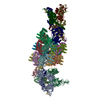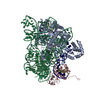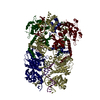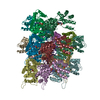[English] 日本語
 Yorodumi
Yorodumi- PDB-8rku: Conformational Landscape of the Type V-K CRISPR-associated Transp... -
+ Open data
Open data
- Basic information
Basic information
| Entry | Database: PDB / ID: 8rku | |||||||||
|---|---|---|---|---|---|---|---|---|---|---|
| Title | Conformational Landscape of the Type V-K CRISPR-associated TransposonIntegration Assembly CAST V-K TnsC domain local-refinement map | |||||||||
 Components Components |
| |||||||||
 Keywords Keywords | DNA BINDING PROTEIN / CRISPR-associated Transposon genome editing transposition | |||||||||
| Function / homology | Bacterial TniB / Bacterial TniB protein / : / P-loop containing nucleoside triphosphate hydrolase / ADENOSINE-5'-TRIPHOSPHATE / DNA / DNA (> 10) / DNA (> 100) / TnsC Function and homology information Function and homology information | |||||||||
| Biological species |  Scytonema hofmannii (bacteria) Scytonema hofmannii (bacteria) | |||||||||
| Method | ELECTRON MICROSCOPY / single particle reconstruction / cryo EM / Resolution: 2.3 Å | |||||||||
 Authors Authors | Tenjo-Castano, F. / Mesa, P. / Montoya, G. | |||||||||
| Funding support |  Denmark, European Union, 2items Denmark, European Union, 2items
| |||||||||
 Citation Citation |  Journal: Mol Cell / Year: 2024 Journal: Mol Cell / Year: 2024Title: Conformational landscape of the type V-K CRISPR-associated transposon integration assembly. Authors: Francisco Tenjo-Castaño / Nicholas Sofos / Luisa S Stutzke / Piero Temperini / Anders Fuglsang / Tillmann Pape / Pablo Mesa / Guillermo Montoya /  Abstract: CRISPR-associated transposons (CASTs) are mobile genetic elements that co-opt CRISPR-Cas systems for RNA-guided DNA transposition. CASTs integrate large DNA cargos into the attachment (att) site ...CRISPR-associated transposons (CASTs) are mobile genetic elements that co-opt CRISPR-Cas systems for RNA-guided DNA transposition. CASTs integrate large DNA cargos into the attachment (att) site independently of homology-directed repair and thus hold promise for eukaryotic genome engineering. However, the functional diversity and complexity of CASTs hinder an understanding of their mechanisms. Here, we present the high-resolution cryoelectron microscopy (cryo-EM) structure of the reconstituted ∼1 MDa post-transposition complex of the type V-K CAST, together with different assembly intermediates and diverse TnsC filament lengths, thus enabling the recapitulation of the integration complex formation. The results of mutagenesis experiments probing the roles of specific residues and TnsB-binding sites show that transposition activity can be enhanced and suggest that the distance between the PAM and att sites is determined by the lengths of the TnsB C terminus and the TnsC filament. This singular model of RNA-guided transposition provides a foundation for repurposing the system for genome-editing applications. | |||||||||
| History |
|
- Structure visualization
Structure visualization
| Structure viewer | Molecule:  Molmil Molmil Jmol/JSmol Jmol/JSmol |
|---|
- Downloads & links
Downloads & links
- Download
Download
| PDBx/mmCIF format |  8rku.cif.gz 8rku.cif.gz | 741.8 KB | Display |  PDBx/mmCIF format PDBx/mmCIF format |
|---|---|---|---|---|
| PDB format |  pdb8rku.ent.gz pdb8rku.ent.gz | 614.1 KB | Display |  PDB format PDB format |
| PDBx/mmJSON format |  8rku.json.gz 8rku.json.gz | Tree view |  PDBx/mmJSON format PDBx/mmJSON format | |
| Others |  Other downloads Other downloads |
-Validation report
| Summary document |  8rku_validation.pdf.gz 8rku_validation.pdf.gz | 2.2 MB | Display |  wwPDB validaton report wwPDB validaton report |
|---|---|---|---|---|
| Full document |  8rku_full_validation.pdf.gz 8rku_full_validation.pdf.gz | 2.2 MB | Display | |
| Data in XML |  8rku_validation.xml.gz 8rku_validation.xml.gz | 105 KB | Display | |
| Data in CIF |  8rku_validation.cif.gz 8rku_validation.cif.gz | 164.3 KB | Display | |
| Arichive directory |  https://data.pdbj.org/pub/pdb/validation_reports/rk/8rku https://data.pdbj.org/pub/pdb/validation_reports/rk/8rku ftp://data.pdbj.org/pub/pdb/validation_reports/rk/8rku ftp://data.pdbj.org/pub/pdb/validation_reports/rk/8rku | HTTPS FTP |
-Related structure data
| Related structure data |  19283MC  8axaC  8axbC  8rduC  8rktC  8rkvC C: citing same article ( M: map data used to model this data |
|---|---|
| Similar structure data | Similarity search - Function & homology  F&H Search F&H Search |
- Links
Links
- Assembly
Assembly
| Deposited unit | 
|
|---|---|
| 1 |
|
- Components
Components
-DNA chain , 2 types, 2 molecules 23
| #1: DNA chain | Mass: 20961.504 Da / Num. of mol.: 1 / Source method: obtained synthetically / Source: (synth.)  Scytonema hofmannii (bacteria) Scytonema hofmannii (bacteria) |
|---|---|
| #2: DNA chain | Mass: 40822.160 Da / Num. of mol.: 1 / Source method: obtained synthetically / Source: (synth.)  Scytonema hofmannii (bacteria) Scytonema hofmannii (bacteria) |
-Protein , 1 types, 14 molecules DEFGHIJKLMNOPQ
| #3: Protein | Mass: 31400.496 Da / Num. of mol.: 14 Source method: isolated from a genetically manipulated source Source: (gene. exp.)  Scytonema hofmannii (bacteria) / Production host: Scytonema hofmannii (bacteria) / Production host:  |
|---|
-Non-polymers , 3 types, 566 molecules 




| #4: Chemical | ChemComp-MG / #5: Chemical | ChemComp-ATP / #6: Water | ChemComp-HOH / | |
|---|
-Details
| Has ligand of interest | Y |
|---|
-Experimental details
-Experiment
| Experiment | Method: ELECTRON MICROSCOPY |
|---|---|
| EM experiment | Aggregation state: PARTICLE / 3D reconstruction method: single particle reconstruction |
- Sample preparation
Sample preparation
| Component | Name: Type V-K CRISPR-associated transposon post-transposition state after transesterification Type: COMPLEX / Entity ID: #1-#3 / Source: RECOMBINANT |
|---|---|
| Molecular weight | Value: 1 MDa / Experimental value: NO |
| Source (natural) | Organism:  Scytonema hofmannii (bacteria) Scytonema hofmannii (bacteria) |
| Source (recombinant) | Organism:  |
| Buffer solution | pH: 7 |
| Specimen | Embedding applied: NO / Shadowing applied: NO / Staining applied: NO / Vitrification applied: YES |
| Specimen support | Grid material: GOLD / Grid mesh size: 300 divisions/in. / Grid type: UltrAuFoil R0./1 |
| Vitrification | Cryogen name: ETHANE |
- Electron microscopy imaging
Electron microscopy imaging
| Experimental equipment |  Model: Titan Krios / Image courtesy: FEI Company |
|---|---|
| Microscopy | Model: FEI TITAN KRIOS |
| Electron gun | Electron source:  FIELD EMISSION GUN / Accelerating voltage: 300 kV / Illumination mode: FLOOD BEAM FIELD EMISSION GUN / Accelerating voltage: 300 kV / Illumination mode: FLOOD BEAM |
| Electron lens | Mode: BRIGHT FIELD / Nominal defocus max: 2000 nm / Nominal defocus min: 800 nm |
| Specimen holder | Specimen holder model: FEI TITAN KRIOS AUTOGRID HOLDER |
| Image recording | Electron dose: 40 e/Å2 / Film or detector model: FEI FALCON IV (4k x 4k) / Num. of real images: 19936 |
| EM imaging optics | Energyfilter name: TFS Selectris X |
- Processing
Processing
| EM software |
| ||||||||||||||||||||||||||||||||
|---|---|---|---|---|---|---|---|---|---|---|---|---|---|---|---|---|---|---|---|---|---|---|---|---|---|---|---|---|---|---|---|---|---|
| CTF correction | Type: PHASE FLIPPING AND AMPLITUDE CORRECTION | ||||||||||||||||||||||||||||||||
| 3D reconstruction | Resolution: 2.3 Å / Resolution method: FSC 0.143 CUT-OFF / Num. of particles: 258000 / Symmetry type: POINT | ||||||||||||||||||||||||||||||||
| Atomic model building | Protocol: AB INITIO MODEL | ||||||||||||||||||||||||||||||||
| Atomic model building | Source name: AlphaFold / Type: in silico model |
 Movie
Movie Controller
Controller








 PDBj
PDBj








































